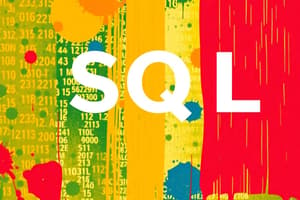Podcast
Questions and Answers
What are commands in the context of databases?
What are commands in the context of databases?
- They represent database transactions.
- They are used for data storage.
- They are called queries ad-hoc understand SQL. (correct)
- They refer to user interface operations.
What does Application Programs refer to?
What does Application Programs refer to?
GUI, business logic so machine can act on user's commands on client's machine.
What are Personal Databases designed for?
What are Personal Databases designed for?
Support one user and manage small amounts of data efficiently.
What is a Two-Tier Client/Server Database?
What is a Two-Tier Client/Server Database?
What are Multi-tier Client/Server Databases used for?
What are Multi-tier Client/Server Databases used for?
What do Enterprise Applications encompass?
What do Enterprise Applications encompass?
Define Enterprise Resource Planning (ERP).
Define Enterprise Resource Planning (ERP).
What is a Data Warehouse?
What is a Data Warehouse?
What is the Evolution of Database Systems?
What is the Evolution of Database Systems?
What are some Driving Factors for evolving database systems?
What are some Driving Factors for evolving database systems?
What happened in the 1960s in relation to database management systems?
What happened in the 1960s in relation to database management systems?
What was significant about the 1970s for database systems?
What was significant about the 1970s for database systems?
What advancements were made in the 1980s for database technology?
What advancements were made in the 1980s for database technology?
What trends characterized the 1990s in database development?
What trends characterized the 1990s in database development?
Flashcards are hidden until you start studying
Study Notes
Database Applications Overview
- Commands, also known as queries, are utilized for data retrieval and manipulation, understanding SQL is essential.
- Application programs feature a graphical user interface (GUI) and implement business logic, allowing machines to process user commands. The Database Management System (DBMS) acts as an intermediary between the user interface and the database server.
Types of Databases
- Personal databases support single users, primarily on PCs, efficiently managing small data volumes without sharing. Commonly used by salespeople for personal productivity.
- Two-tier client/server databases support small workgroups (up to 25 people), focusing on data security and integrity. Each client requires interface and business logic updates.
- Multi-tier client/server databases serve larger departments or divisions. They include an application-level web server layer that manages business logic and communicates with the database server, enhancing performance and maintainability.
- Enterprise applications span multiple departments and may include multiple enterprise databases for comprehensive management.
Advanced Database Concepts
- Enterprise Resource Planning (ERP) integrates all business functions, facilitating the management of various operational activities such as sales, manufacturing, and finance.
- Data warehouses serve as centralized databases for decision support, integrating data from operational databases, intranets, and extranets, and focusing on analyzing historical data trends and patterns.
Evolution of Database Systems
- Database systems began in the 1960s with flat file models, evolving through hierarchical and network models, leading to the relational model in the 1980s, which organizes data in tables and relationships.
- Object-oriented databases emerged, followed by object-relational databases that combine features of both models. Data warehousing introduced multidimensional databases structured in cubes or star schemas.
Driving Factors for Database Development
- Increasing data independence between programs and data reduces maintenance overhead.
- Complex data types and structures require robust management capabilities.
- Demand for quick access to data fosters user-friendly interfaces even for non-technical users.
- Powerful platforms for decision support applications enhance business intelligence capabilities.
Historical Context
- 1960s marked the introduction of file processing systems and the first database management systems, coinciding with events like the moon landing and growing data standardization.
- 1970s saw the emergence of hierarchical and network models, considered first-generation DBMS with limited data independence and lengthy development periods.
- 1980s favored the relational model alongside the rise of client/server computing and graphical user interfaces.
- 1990s brought forth multimedia data capabilities and the advent of object-oriented databases, alongside the growing importance of data warehousing.
Studying That Suits You
Use AI to generate personalized quizzes and flashcards to suit your learning preferences.



